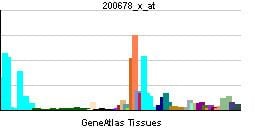Entrez 2896 | Ensembl ENSG00000030582 | |
 | ||
Aliases GRN, CLN11, GEP, GP88, PCDGF, PEPI, PGranulin External IDs MGI: 95832 HomoloGene: 1577 GeneCards: GRN | ||
Structure
Granulins are a family of secreted, glycosylated peptides that are cleaved from a single precursor protein with 7.5 repeats of a highly conserved 12-cysteine granulin/epithelin motif. The 88 kDa precursor protein, progranulin, is also called proepithelin and prostate cancer (PC) cell-derived growth factor. Cleavage of the signal peptide produces mature granulin which can be further cleaved into a variety of active, 6 kDa peptides. These smaller cleavage products are named granulin A, granulin B, granulin C, etc. Epithelins 1 and 2 are synonymous with granulins A and B, respectively.
Function
Both the peptides and intact granulin protein regulate cell growth. However, different members of the granulin protein family may act as inhibitors, stimulators, or have dual actions on cell growth. Granulin family members are important in normal development, wound healing, and tumorigenesis.
Clinical significance
The human liver fluke (Opisthorchis viverrini) contributes to the development of bile duct (liver) cancer by secreting a granulin-like growth hormone.
Mutations in the GRN gene have been implicated in up to 25% of frontotemporal lobar degeneration, inherited in an autosomal dominant fashion with high penetrance. Several loss-of-function mutations disease-causing mutations in GRN have been identified.
Granulin release by macrophages has been associated with fibrotic hepatic metastasis in pancreatic cancer.
Interactions
Granulin has been shown to interact with Cyclin T1 and TRIB3.
